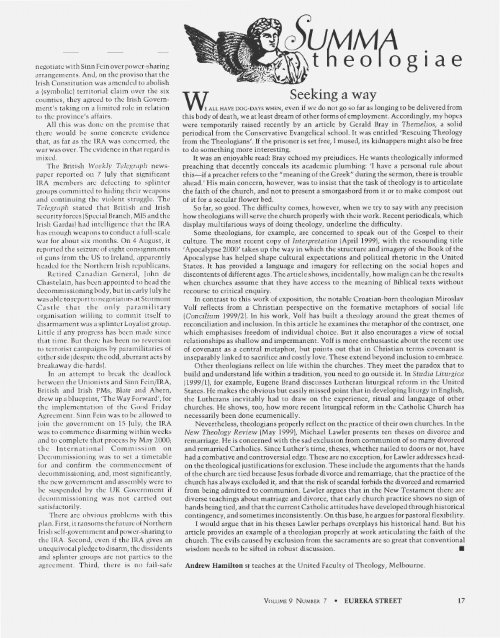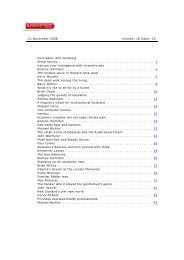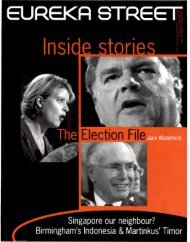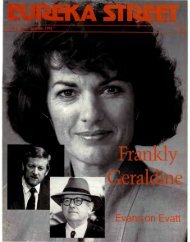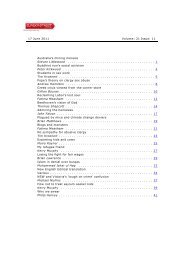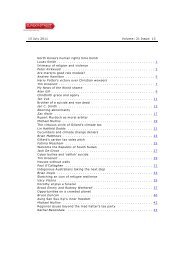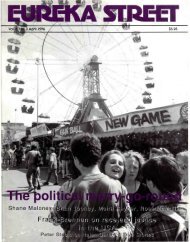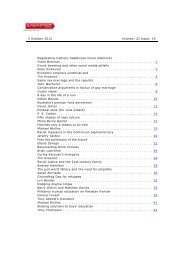1 - Eureka Street
1 - Eureka Street
1 - Eureka Street
- No tags were found...
Create successful ePaper yourself
Turn your PDF publications into a flip-book with our unique Google optimized e-Paper software.
negotiate with Sinn Fein over power-sharingarrangements. And, on the proviso that theIrish Constitution was amended to abolisha (symbolic) territorial claim over the sixcounties, they agreed to the Irish Government'staking on a limited role in relationto the province's affairs.All this was done on the premise thatthere would be som e concrete evidencethat, as far as the IRA was concerned, thewar was over. The evidence in that regard ismixed.The British Weekly Telegraph newspaperreported on 7 July that significantIRA members are defecting to splintergroups committed to hiding their weaponsand continuing the violent struggle. TheTelegraph stated that British and Irishsecurity forces (Special Branch, MIS and theIrish Gardai) had intelligence that the IRAhas enough weapons to conduct a full-scalewar for about six months. On 4 August, itreported the seizure of eight consignmentsof gu ns from the US to Ireland, apparentlyheaded for the Northern Irish republicans.Retired Canadian General, John deChastelain, has been appointed to head thedecommissioning body, but in early July hewas able to report to negotiators at StormontCastle that the only paramilitaryorganisation willing to commit itself todisarmament was a splinter Loyalist group.Little if any progress has been made sincethat time. But there has been no reversionto terrorist campaigns by para militaries ofeither side (despite the odd, aberrant acts bybreakaway die-hards).In an attempt to break the deadlockbetween the Unionists and Sinn Fein/IRA,British and Irish PMs, Blair and Ahern,drew up a blueprint, 'The Way Forward', forthe implementation of the Good FridayAgreement. Sinn Fein was to be allowed tojoin the government on 15 July; the IRAwas to commence disarming within weeksand to complete that process by May 2000;the Internati onal Commission onDecommissioning was to set a timetablefor and confirm the commencement ofdecommissioning; and, most significantly,the new government and assembly were tobe suspended by the UK Government ifdecommissioning was not carried outsatisfactorily.There are obvious problems with thisplan. First, it ransoms the future of NorthernIrish elf-government and power-sharing tothe IRA. Second, even if the IRA gi ves anunequivocal pledge to disarm, the dissidentsand splinter groups are not parties to theagreement. Third, there is no fail-safeW .Seeking a way•1 a eALL HAVE DOG-DAYS WHEN, even if we do not go so far as longing to be delivered fromthis body of death, we at least dream of other forms of employment. Accordingly, my hopeswere temporarily raised recently by an article by Gerald Bray in Themelios, a solidperiodical from the Conservative Evangelical school. It was entitled 'Rescuing Theologyfrom the Theologians'. If the prisoner is set free, I mused, its kidnappers might also be freeto do something more interesting.It was an enjoyable read: Bray echoed my prejudices. He wants theologically informedpreaching that decently conceals its academic plumbing: 'I have a personal rule aboutthis-if a preacher refers to the "meaning of the Greek" during the sermon, there is troubleahead.' His main concern, however, was to insist that the task of theology is to articulatethe faith of the church, and not to present a smorgasbord from it or to make compost outof it for a secular flower bed.So far, so good. The difficulty comes, however, when we try to say with any precisionhow theologians will serve the church properly with their work. Recent periodicals, whichdisplay multifarious ways of doing theology, underline the difficulty.Some theologians, for example, are concerned to speak out of the Gospel to theirculture. The most recent copy of Interpretation (April 1999), with the resounding title'Apocalypse 2000' takes up the way in which the structure and imagery of the Book of theApocalypse has helped shape cultural expectations and political rhetoric in the UnitedStates. It has provided a language and imagery for reflecting on the social hopes anddiscontents of different ages. The article shows, incidentally, how malign can be the resultswhen churches assume that they have access to the meaning of Biblical texts withoutrecourse to critical enquiry.In contrast to this work of exposition, the notable Croatian-born theologian MiroslavVol£ reflects from a Christian perspective on the formative metaphors of social life(Concilium 1999/2). In his work, Volf has built a theology around the great them es ofreconciliation and inclusion. In this article he examines the metaphor of the contract, onewhich emphasises freedom of individual choice. But it also encourages a view of ocialrelationship as shallow and impermanent. Vol£ is more enthusiastic about the recent useof covenant as a central metaphor, but points out that in Christian terms covenant isinseparably linked to sacrifice and costly love. These extend beyond inclusion to embrace.Other theologians reflect on life within the churches. They meet the paradox that tobuild and understand life within a tradition, you need to go outside it. In Studio Liturgica(1999/lL for example, Eugene Brand discusses Lutheran liturgical reform in the UnitedStates. He makes the obvious but easily missed point that in developing liturgy in English,the Lutherans inevitably had to draw on the experience, ritual and language of otherchurches. He shows, too, how more recent liturgical reform in the Catholic Church hasnecessarily been done ecumenically.Nevertheless, theologians properly reflect on the practice of their own churche . In theNew Theology Review (May 1999), Michael Lawler presents ten theses on divorce andremarriage. He is concerned with the sad exclusion from communion of so many divorcedand remarried Catholics. Since Luther's time, theses, whether nailed to doors or not, havehad a combative and controversial edge. These are no exception, for Lawler addresses headonthe theological justifications for exclusion. These include the arguments that the handsof the church are tied because Jesus forbade divorce and remarriage, that the practice of thechurch has always excluded it, and that the risk of scandal forbids the divorced and remarriedfrom being admitted to communion. Lawler argues that in the N ew Te tament there arediverse teachings about marriage and divorce, that early church practice shows no sign ofhands being tied, and that the current Catholic attitudes have developed through historicalcontingency, and sometimes inconsistently. On this base, he argues for pastoral flexibility.I would argue that in his theses Lawler perhaps overplays his historical hand. But hisarticle provides an example of a theologian properly at work articulating the faith of thechurch. The evils caused by exclusion from the sacraments are so great that conventionalwisdom needs to be sifted in robust discussion.•Andrew Hamilton SJ teaches at the United Faculty of Theology, Melbourne.V oLUME 9 NuMBER 7 • EUREKA STREET 17


